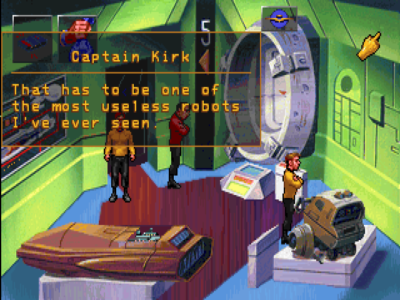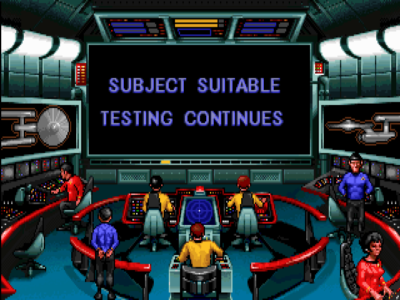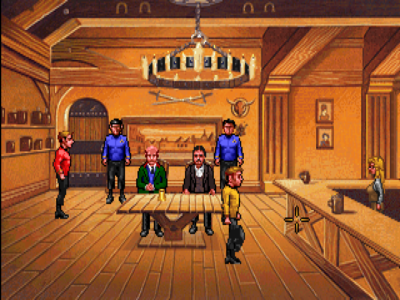
Star Trek: Judgment Rites
Written by: Stoo
Date posted: August 7, 2007
- Genre: Adventure
- Developed by: Interplay
- Published by: Interplay
- Year released: 1993
- Our score: 8
Although I’d happily call myself quite a Trekkie, somehow I’ve never really gotten around to watching much of the original series. Not that I have anything in particular against it; I’m probably just too spoiled by these modern days of flashy CG effects. Still, I did enjoy the spins-offs and movies that it spawned, and fully believe the show deserves a lot of respect. Take the mickey out of the campy nature and plywood sets if you will, it was an important milestone in sci-fi. Forward-looking with an optimistic view of the future, it showed us mankind reaching out to explore the unknown, while at the same time using deep space and aliens as a tool for asking questions about humanity itself.
Nowadays of course there are a multitude of licensed Trek gaming titles – strategy, first-person shooters, simulations. While games with some relationship to Trek had been around since the 80s, they first really took off when the franchise’s 25th anniversary rolled around, way back in 1992. To commemorate this event, Interplay brought us a game called, er, 25th anniversary. A cheerful, colourful affair, it was a game of two parts. One was a fairly simple Enterprise-simulator, putting you in command on the bridge of the ship herself. The other was a point-and-click graphical adventure – this being in the heyday of the genre after all. Split into a series of missions, each structured as a self-contained episode we the lucky trekkie gamers finally had a chance to explore the galaxy. We could meet new races, interact with mighty powers and and foil the federation’s enemies, alongside Kirk, Spock and Mccoy. Its still very much a worthwhile game in my book.
All good games demand a sequel of course, so that’s what we’re looking at today. From the outset it should be clear, that Judgement Rites doesn’t attempt to do much new. There are a few alterations along the way but overall the the gameplay and engine are pretty much the same as last time. Rather it’s best viewed as 25th anniversary part 2, a continuation of that game featuring a new set of episodes. Which, if you enjoyed the first one, is a perfectly acceptable prospect.
First up, the Enterprise bits, and control of the ship is unchanged. The “navigation” is just copy-protection using a map from the manual, whilst quick commands will open hailing frequencies, put the ship in orbit, or ask Spock for his advice (always a good idea). When you reach combat, it’s a case of banking and whirling around space flinging torpedoes. We’re hardly talking Battlecruiser here, just a fairly simple action segment where you can thrash it out with Romulans and other antagonists. Mouse controls movement, buttons launch weapons; there’s just a little more depth to it by such features as trying to keep weakened sides to your defensive shields away from enemies, or choosing where to direct repairs (engine, weapons etc). The one thing that has changed is that you can choose a difficulty level, or in fact turn the combat off altogether if you wish. If you still can’t forgive the ridiculously difficult final battle from 25th anniversary you might be forgiven for picking that option, although generally the ship-to-ship action in these games is an entertaining enough distraction.
Outside combat but still aboard ship, we’re treated to a few pre-rendered cutscenes of the Enterprise at various points, such as encountering an orbital station, or entering orbit. The CG of the day looks rather primitive but it’s only used for spaceship stuff, for which it’s adequate enough. We are at least spared the plastic-looking people that used to feature in early CG sequences. Sequences like entering orbit were handled in-engine previously, so this upgrade is hardly essential, but the cutscenes do allow for more exciting or varied depictions of what’s taking place.
Just as before, though, we’re mainly here for the adventuring sections, where Kirk intrepidly leads a quartet of crew members on a mission of exploration or problem-solving In one mission you’re caught in a fantasy recreation of first-world-war era Germany, created by godlike being Trelane. Another couple of examples are foiling a terrorist attack on a museum, and encountering what appear to be angels and demons in a long-abandoned outpost. A theme cropping up in a few of missions is primitive peoples under the scrutiny or supervision of a superior power, and this comes together in the climax. In the end that over-arching plot ends up being a little bit predictable and cliched, but it’s an enjoyable enough journey there at least. Also, while your companions are usually Spock, Mccoy and Ensign random guy, unlike 25th anniversary that’s not always the case. So Sulu, Checkov, Scottie and Uhura get a chance to stretch their legs occasionally.
Throughout, it’s of a consistently high standard. The environments are well-drawn, even using ye olde VGA they’re quite evocative. The tone is usually bright and upbeat, but sometimes just a little mysterious, suiting the original-Trek setting of bold exploration perfectly. Mccoy and Spock will often argue, heart vs logic as ever, which keeps a bit of a sense of humour to the proceedings. Occasionally it got a bit overtly wordy and I lost track of exactly what the situation was, but I’m not sure if I was just being a bit dense.
Puzzle-solving is pretty well-balanced – challenging at times without making you want to punch something in frustration. What you say to people is often important, after all Kirk is a starfleet captain So while it’s tempting to get snarky or aggressive sometimes, better to stick to the tactful path. Also fellow crewmembers are there to be put to use. That is, except for when they cause problems themselves, an interesting twist that caught me off guard in one mission.
If action interludes put you off in an adventure rest assured that apart from having to quickly reach for phasers once or twice, there’s not too much requiring twitchy reflexes here. Or rather, the enterprise-bits take care of the game’s action quota. It is possible to get the characters killed – which might be off-putting if you’re used to the Lucasarts’ very relaxed style, but usually you’re made quite aware when it’s all going horribly wrong or imminent danger looms. So you won’t get caught out by the kind of arbitrary surprise deaths that sometimes blighted older adventures.
Meanwhile a particular problem often has more than one solution, one of which is deemed the most suitable. At the end of the mission you’re given a score, based on how close to the preferred path you were. The game won’t spell out exactly what you must do to get the top score – that’s left to you to work out for yourself. However given the idealism behind Trek, it should become obvious that you want all problems resolved, and with as little violence as possible. For example, if some armed guards are blocking your path, you might score higher for somehow talking them round to letting you past, rather than shooting them. If you do really badly – say you’re sent to study primative humanoids, and you fail to avert a disaster that kills them all – you might be told it’s game over even if you make it back to the ship in one piece.
As before, as a reward for higher scores the Enterprise is apparently “upgraded” to be more powerful in combat. I never could quite see the difference – and it’s irrelevant if you’ve switched combat off anyway. However, if you’re feeling engaged with the stories (and I was) then knowing your performance was mediocre can often be incentive to go back and try again, even if you’re not obliged to.
So here’s the summary: this is an oldie I don’t have any problem recommending to gaming trekkies today. For one thing its a firmly held opinion on this site that good adventures, except for maybe the really old ones, age well. Perhaps the best of any genre, in fact. There’s another point though, its one I raised in the review in the review of the TNG-based Final Unity also: modern Trek games tend to focus a lot on shooting and battles. If you want to keep closer to Trek’s themes of exploration and discovery, these older adventure might be your best bet.
Like its predecessor this one has buckets of atmosphere, real character and captures the Trek spirit well. I wish I could be as bold as to say that even non-trekkies will enjoy this, but that might be a little presumptuous. For those with at least a minor interest in a gaming interpretation of the classic series, though, this is a great way to spend a rainy saturday.





 Posts
Posts